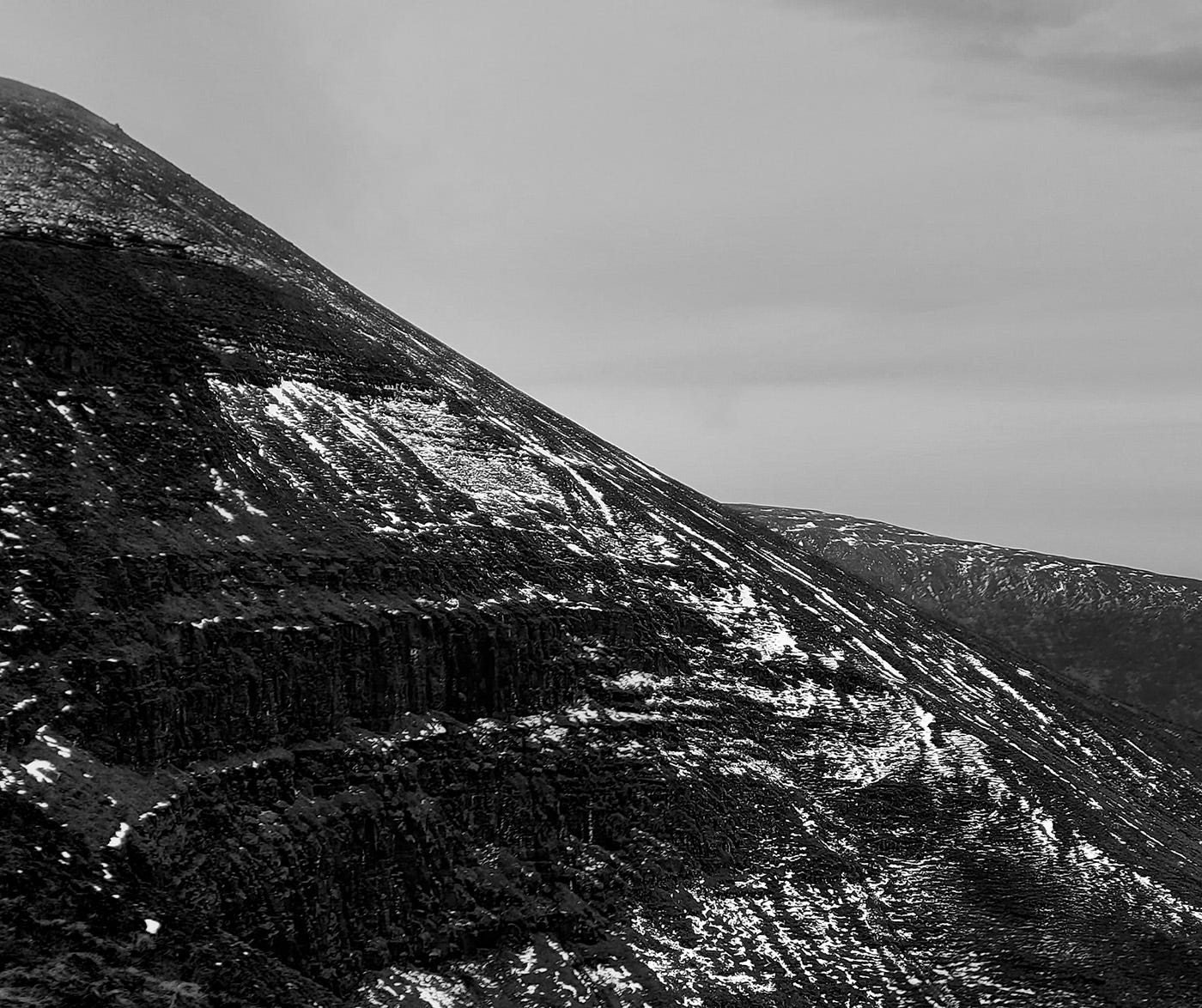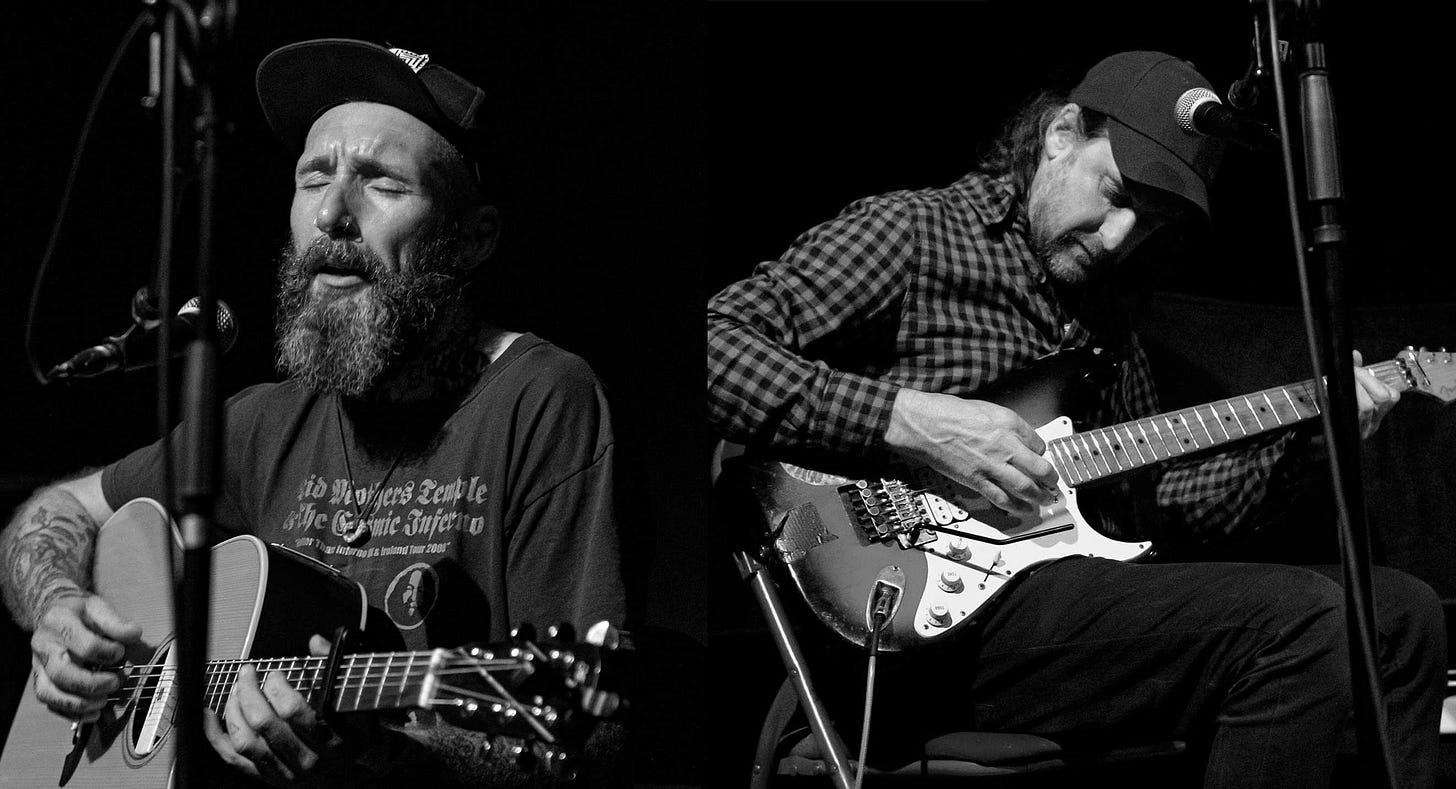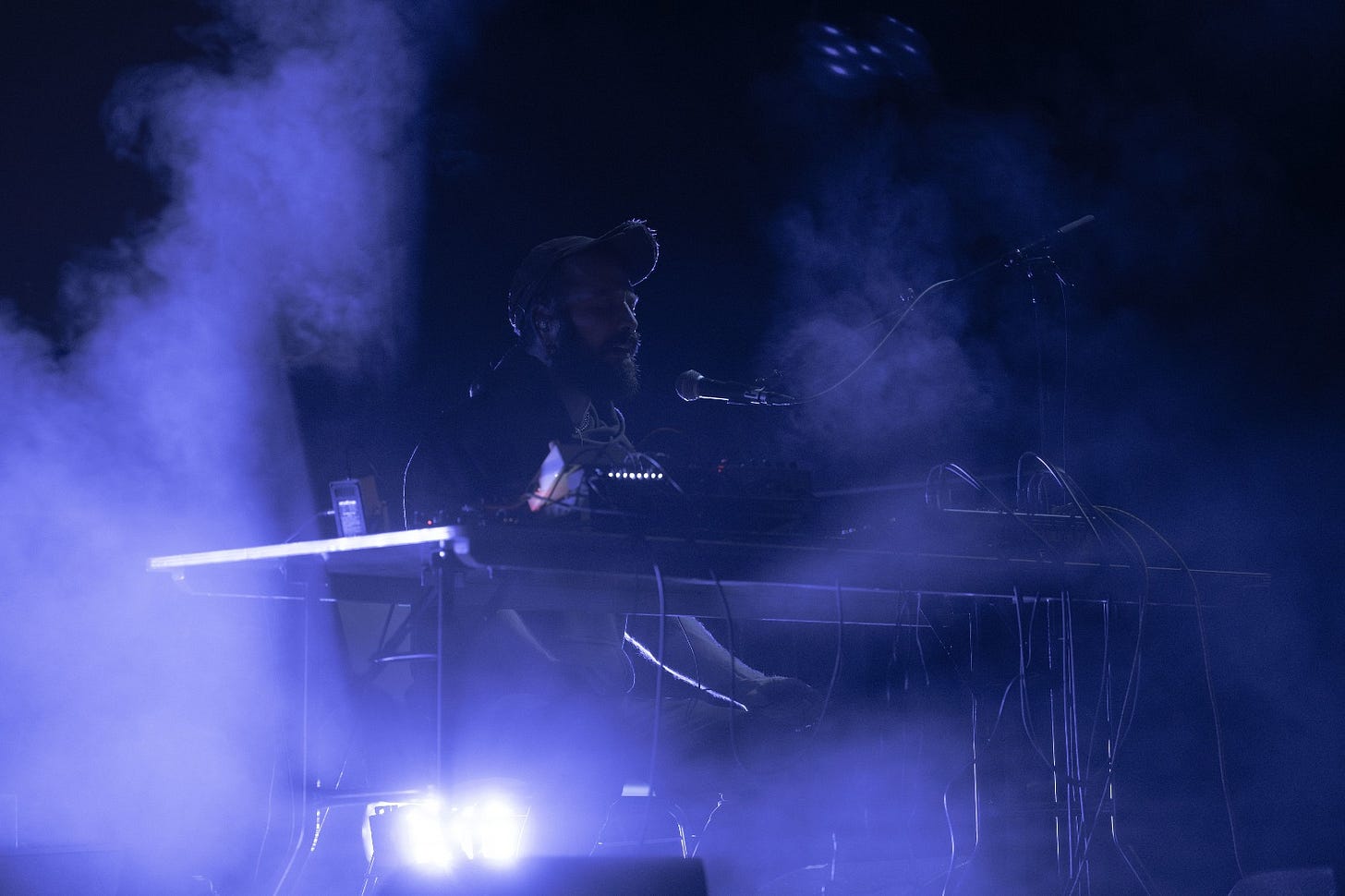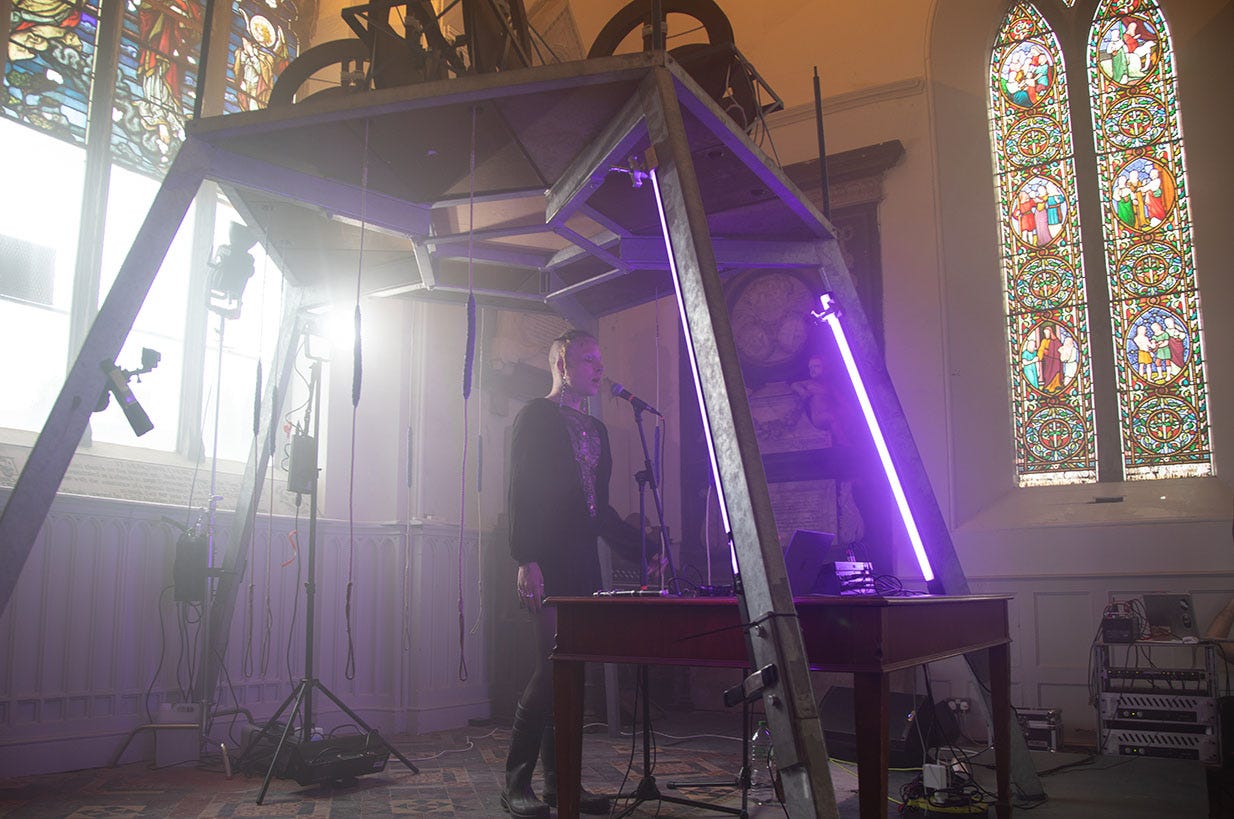Exploring the drone in Irish music
A story of sustained tones, sacred rituals, and the search for connection with the world around us, told with the help of Ian Lynch, Paddy Shine and Baptist Goth.
Ar aghaidh is ar aghaidh is ar aghaidh.
“In the beginning was the word, and the word was with God. And the word was God. One word. One syllable. One frequency.”
It’s a cold Monday night in October 2021 and, in East London’s Cafe OTO, Ian Lynch is delivering his cosmological ode to the drone. Over a billowing swell of sub-bass and distorted synth, the Lankum musician’s voice reverberates slowly through the intimate space, introducing this live edition of his Fire Draw Near podcast, which “investigates Irish traditional music and song in all of its myriad forms”. Tonight, he’ll chart the complex history of the anti-war song ‘Johnny I Hardly Knew Ye’, but first, he encourages us to cast our minds further back, to the sound that started it all.
He continues: “Our earliest ancestor was not a single cell organism, but a single vibration, born of electromagnetic radiation, transmitting through the universe 13.9 billion years ago. But eventually, the signal split. Eventually, it multiplied. Eventually, it became everything we know: the earth, the wind, the water, the fire, the luminiferous ether, and us – living, breathing, stinking, and tragic. All of us descending from the same source, and within each of us, the in-built desire to be back there once more, vibrating at the same frequency as everything else in existence. Instead, we find ourselves flung through the cosmos upon this dying rock at great speeds, in the wrong direction. Wave upon wave upon wave upon wave. And without the stories to show us the way, we might never find ourselves again.”
A little over two years later, shortly before Lynch brings his experimental solo project One Leg One Eye to a live setting for the first time at Berlin’s CTM Festival, he tells me that this monologue originated after he did some reading into the imperceptibly deep hum of Cosmic Background Radiation – “essentially, remnants of the Big Bang”. It left him considering the notion that “all life in the universe stemmed from this great eternal drone, and how the unity that we all seek is to be a part of this vibration”.
“Our interactions with drone in music are a form of sacred ritual,” he says, “and the closest thing we have to achieving this oneness.”
You don’t have to look hard to find the truth in this sentiment; through every epoch of human history, our fascination with the drone is plain to see. As the writer Harry Sword puts it in his essential tome, Monolithic Undertow: In Search of Sonic Oblivion: “The drone is found everywhere from Buddhist chant, to Indian raga, free jazz to ambient techno, minimalism to industrial, not to mention the myriad drones of nature.”
From ancient instruments used in spiritual ceremonies, through the works of La Monte Young and the Theatre of Eternal Music, Alice Coltrane, Pauline Oliveros and Ravi Shankar, into the distorted zones of Sunn O))), Jah Shaka and Earth, its immersive force has drawn us in again and again and again – a connective tissue between cultures all over the globe, united in their quest for transcendence.
In Ireland, this resonance runs deep, echoing through centuries of traditional music, culture, and the landscape itself. Lynch is among a raft of artists and labels who, in 2024, are revitalising the country’s long-held love for low, sustained tones. Nowadays, its felt in the feverish thrum of DIY shows and trad sessions alike; in the nasal timbre of unaccompanied sean-nós singing and the natural buzz of field recordings; in the booming bells and organs of churches, and the electric groan of digital synths.
You can hear it in Lynch’s vocals, uilleann pipes, concertinas and whistles, which, as One Leg One Eye and in Lankum’s celebrated LPs and live shows, he envelopes in a thick fog of doom and dark ambient influences. Lankum’s producer John “Spud” Murphy injects similar plumes of relentless bass weight into the music of OXN, Katie Kim and Percolator.
Elsewhere, artists like John Francis Flynn and Gareth Quinn Redmond twist canonical folk songs and instrumentation around pillars of soft-focus ambience, crackling distortion and tape hiss, while Declan Synnot, Michelle Doyle and Cliona Ni Laoi work with harsher palettes.
Meanwhile, acts like Áine O'Dwyer, Eamon Ivri, Queef, Katie Gerardine O'Neill, Natalia Beylis and Moundabout augment audio snippets extracted directly from the environment, transforming them into abstract, otherworldly tunes. Others, like Baptist Goth, harness the sacred qualities of the drone as a way of exploring and conceptualising time itself, tapping into ancient frequencies and tracing their journey through generations, locations and communities into the present day.
Among this burgeoning movement of musicians, who are mapping the terrain between classic forms and the contemporary undergrowth, the drone offers common ground; a shared language in an ever-evolving story of Irish music.
There are numerous words for drone as Gaeilge. The most common of those, dord, is also the name given to a particular type of ancient bronze horn, which dates back to 1000 BC, and is thought to have produced a sound similar to that of a didgeridoo. As Lynch points out, dord is also the word used to describe the noise a stag makes, a buzzing or a chant, and the sound of the pipes.
The earliest representation of a set of mouth-blown bagpipes in Ireland dates back to around 1550, in a stone carving found in Woodstock Castle, Co. Kilkenny, which depicts them being played with the standard two drones attached. The bellows-driven uilleann pipes – with their warmer timbre produced using three drones, regulators and melodic chanter – were developed during the 18th century and, over time, became a signature instrument in Irish folk music, preserved by the likes of Séamus Ennis and Na Píobairí Uilleann organisation, and made famous by the likes of Planxty’s Liam O’Flynn, The Bothy Band’s Paddy Keenan, and The Chieftains' Paddy Moloney.
In the sean-nós tradition, the droning, nasal effect of the voice – or, the “nyahh” – was once described by the Connemara-born singer Joe Heaney as representing “the sound of a thousand Irish pipers all through history”. The “nyahh”, which is elsewhere more loosely defined as the “soul” or “lift” in the music, is something Heaney understood as existing between the “words and the language”, and was something he also recognised in the voices of Native American, Azerbaijani and Indian singers.
This hard-to-pin-down quality enticed the Leitrim-based musician Willie Stewart too, so much so that he launched the Nyahh Records label in 2021 as a “home for sound collectors, noise makers and music builders” located largely, though not exclusively, in Ireland. It released One Leg One Eye’s debut album .... And Take The Black Worm With Me in October 2022 and, in 2023, inspired by the song collecting of Alan Lomax, delivered two crucial anthologies: A Collection of Songs in the Traditional & Sean-Nós Style and Under the Island: Experimental Music in Ireland 1960 - 1994.
When I interviewed Stewart about Nyahh Records in 2022 for The Thin Air, he spoke about his interest in the work of the filmmaker Bob Quinn, whose Atlantean documentary film series explored the shared culture between Irish and North African people. “I feel like the ‘nyahh’ is a huge part of that connection,” he said. “The similarities in sean-nós and North African Amazigh music are undeniable. It’s all so focused on drones… I think everyone knows what the ‘nyahh’ is. They just might not know the word.”
This understanding of the drone as a phenomenon shared between cultures is echoed by Moundabout’s Paddy Shine, who first met his bandmate Phil Masterson in 2010 at Stewart and Natalia Beylis’ Hunter’s Moon Festival. For Shine, who’s also a founding member of the psychedelic outfit Gnod, the vibrational energy of pub trad sessions that made the hairs on the back of his neck stand up as a kid in Athlone mirrored that of the Berber and Gnawa music gatherings he visited years later in Morocco.
“It’s the exact same thing going on,” he says. “It was all coming from one place, and that place was the drone, that resonant force… That's how it kind of started to make sense to me. It was like, okay, this all comes from the same source. It’s just about tapping into that. And that’s what the drone does. It allows us to tap into that primal part of ourselves. And we can all very easily join in on that drone. Anybody can get involved.”
It’s that universality and accessibility of the drone that drew Shine in as he started making music; he would tune all the strings of his guitar to a single note, and sing over his open strums. “You're already flying then,” he laughs, “because it starts to play itself.”
Shine and Masterson’s acoustic and electric guitar playing on their 2023 album An Cnoc Mór is similarly expansive. Whirring chord progressions and jangling riffs are held in place with quivering strings, battered Hammond drum machine beats and mantra-like vocals. Across six tracks, the pair weave tendrils of desert blues and pagan folk loosely through kaleidoscopic passages of kosmische and earthy psychedelia.
The album takes its name from Cnoc Mór na nGaibhlte, one of Ireland’s highest mountains, and the tallest of the Galtees, a range where the counties Tipperary, Limerick and Cork intersect. In 2022, Shine and Masterson rented a yurt among these hills, and would go on long hikes or swim in nearby rivers every morning before getting to work on music.
A recurrent sound across the album is that of the environment in which it was made. A sample of the wind on the mountain is heard on the album’s opening track ‘The Hills Hum Hymns’ – a rustling gust that courses over its rugged sonic terrain. These recordings provide a backbone of sustain to the tracks, a hypnotically droning foothold for the music, built into its birthplace. Here, the Galtees themselves become an instrument, played as intuitively as breathing. “It’s in the air, isn’t it?” says Shine. “It's in the air of where we live.”
Lynch’s relationship with the drone started early too, and came just as naturally as it did to Shine. “I remember when I was very young, about five or six, me and my brother Daragh would often just hum sustained notes at each other for long periods of time,” he says. “I’ve no idea why we started doing this, but I can remember just getting lost in the resonances and sounds that we both created.
“The sound of the drone of the pipes, particularly in the work of Planxty, was something that I gravitated towards very early in my discovery of traditional music, and that sound has remained very close to me ever since,” he adds. “Usually, when someone is learning to play the pipes they will start off with what is known as a ‘practice-set’; that is a bag, bellows and chanter. The drones are then added at a later stage. I remember when I first got a set of pipes with drones I was so blown away. I would just sit there for hours playing the drones by themselves, feeling them as much as hearing them. I think I liked them even more than the sound of the chanter.”
Like Moundabout, Lynch makes use of field recordings from the world around him on .... And Take The Black Worm With Me, captured in Dublin locales like Bulloch Harbour, Baldoyle Racecourse, Bayside Dart Station, and further afield in Vilnius Cathedral. Across the album’s five tracks, he manipulates these sounds into immense droning instruments alongside his pipes, shruti box, synths, concertina, hurdy gurdy, tape loops and guitar.
Speaking about the creaking instrumental ‘The Fancy Cannot Cheat So Well’ on the No Place Like Drone show on Dublin Digital Radio, Lynch described recording the sounds he detected in the area surrounding an electricity substation, and how their frequencies would seem to vary at different times through the day. “It’s quite amazing when you start to listen to these things and you can hear the musicality in it,” he said. “With industrial or electronic noises, it’s something you wouldn’t commonly associate with having any kind of warmth or inherent musicality. It seems to be on another end of the spectrum. It’s a cold harsh sound that’s so far removed from the human experience. But when you can find the beauty and the music within that, it's quite a rewarding experience.”
On the opening track, ‘Glistening, She Emerges’, Lynch’s uilleann pipes howl like banshees in a cloud of processed tape loops and distorted bass. A filmed early recording of the album’s gorgeous centrepiece, ‘I’d Rather Be Tending My Sheep’, a song collected (or possibly written) by Ruth Tongue, emerged during lockdown. At the time, Lynch would visit an abandoned factory where his father had once worked, and sing accompanied by his shruti box. In the video, you can sense the echo of the warehouse around him, the natural drones of the city emerging from an industrial shell.
Elsewhere, harsh electronic drones converge with traditional music on ‘Bold and Undaunted Youth’, an adapted version of the ‘Newry Highwayman’, which dates back to 1788.
Lynch’s merging of experimental sounds and processes with traditional music is hardwired – an unshakeable instinct to explore the possibilities and extremities of these instruments and songs on his own terms. “From a very early age I have always had a difficult relationship with Irish traditional culture, whether that is the language, the music or the singing,” he says. “Each stage of my creative output has had to do with my untangling and working out of this unease, whether that has been through hardcore punk with The Dagda, black metal with Sodb, experimental folk with Lankum, and most recently in composing the soundtrack to the film All You Need is Death.
“I have never been able to properly express myself playing straight up traditional music and so I have always tried to find my own voice and to find a way to interact with the tradition in a way that is true to my own internal musical reality. Quite often this involves utilising various sounds associated with the tradition in new and unique ways with internal markers of arbitration being informed by my own musical tastes and proclivities.”
This will be demonstrated once again on the forthcoming album by Crone, a project “based on myths surrounding various manifestations of the sovereignty goddess” that Lynch has been working on with musician George Brennan (BB84, Cholera House, Melodica Deathship, Deep Burial) and actor Olwen Fouéré.
For the multidisciplinary artist Dylan Kerr, whose music and site-specific performances regularly revolve around overlapping layers of choral vocals and durational sound, the drone is not just an integral component of their creative practice, but a long-held connective power attached to ideas of space, family, time and spirituality. As a child growing up in Portlaoise, they sang in their church choir accompanied by the organ; they played flute in their local Comhaltas Ceoltóirí Éireann group alongside an uilleann piper, and their uncle played in a band with a bagpiper.
Kerr describes the music they compose and perform under the Baptist Goth persona as sacred; their work explores the “embodied languages of ritual, protest and worship, and the different things that can emerge from them”. “I'm really interested in ritual,” they say, “and rituals in relation to the church and sacred music.”
During their concert at St. Munchin's Church in Limerick last year at Féile na Gréine festival, bells tolled round their reverberating voice and searing electronics. For another set at Dublin’s Pepper Canister Church, they were given permission to play on its 17th century organ. “It was really intense to be in that space and to be allowed to access this instrument,” they remember. “All of the history that is connected to that place – holding that, and then shifting it somehow.”
Like Lynch, Kerr interacts with these revered traditional materials and spaces with a radically personal touch; their art has encapsulated themes of queerness and memory, and uncovers different ways of understanding what it means for something to be sacred within that process. “Performing in churches is a big way to be able to shift the narrative of what people expect of these spaces,” they say. “Churches are amazing spaces that are very energetically heavy for a lot of people.”
For Kerr, the church in their hometown is reflective of that idea. Last summer, after singing there for their sister's wedding, they struck up a rapport with the rector, who told them they could come play the organ whenever they liked. “The first time I went there was really intense actually,” they remember. “I wasn't able to play for the first hour I was there. I was just sitting there crying. My family has always been connected to this church. The organ has this plaque for my great aunt, who worked in the clergy because she left money in her will that paid for the electric blower connected to the pipes.”
“It was just like, all of these things, piecing them together and going to play it was this meditative thing,” they continue. “I feel like I'm connecting with these inner parts of myself, but then also intergenerationally with my family, who've been through this place, and my community back home. I was totally reshaping and reframing my experience of this space.”
Here, the drone and its vessel, so deeply rooted in Irish Catholic liturgy, becomes a window to history; an illuminating thread between the past and present, the traditional and contemporary. It’s a characteristic shared with the music of other Ireland-based artists for whom these church organs are a primary instrument, like Colm Keady-Tabbal and Robert Curgenven. More potent still, for Kerr, the drone and these ritualistic sounds can enable us to transcend time entirely, and enter a frame of mind of pure, empathetic listening.
“A big thing for me in my work is [exploring] time as a material… and the drone’s ability to shift and stretch time. But then there are also these patterns of repetition; I'm also working a lot with chant. In entering these deep, meditative, repetitive spaces, we can become incredibly introspective. Also, in experiencing this type of music as an audience member with other people, it becomes a space where everybody is holding space for each other in that moment.”
You can hear it in a recently released live recording from Dublin’s Unit 44 on Berlin label 3 X L, and in standalone pieces like ‘I wake up in the morning and I cry’ featuring Natalia Beylis. At Kerr’s most recent lives shows, at CTM Festival in Berlin and The National Concert Hall in Dublin with GASH Collective, they’ve woven microtonally tuned sin waves through fragments of sean-nós and overtone singing, all in tribute to the late Swedish experimental pioneer Catherine Christer Hennix, whose cosmic drone music sought connections between Indian ragas, Arabic maqams and the blues, and St. Brigid, one of Ireland’s patron saints. “She’s the mother of the snakes that St. Patrick got rid of,” smiles Kerr. “She's just a bit more punk.”
The drone is an invitation – a radical, intercultural magnet that defies arbitrary borders, and brings us together; a global chorus of frequency that goes on and on and on; ar aghaidh is ar aghaidh is ar aghaidh. “It’s something that is constant through all ages and with all people, throughout the world,” says Lynch. “It is one of those universal things that transcends boundaries – temporal, spatial, political, cultural and natural.”
As a new wave of Irish musicians taps into this signal, it simultaneously sends it outward in its own accent, in search of that connection. We’d do well to welcome whatever response may come with open arms and open ears. Can you hear it? Eistigí.
Thanks for reading! Come back next month for another round-up of new Irish music, and an exciting essay for spring. In the meantime, be well!








This is EXACTLY the article I wanted to read after flipping out over Lankum.
Great article